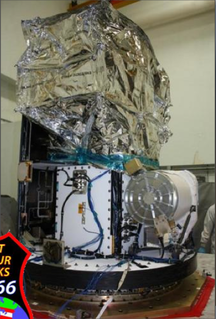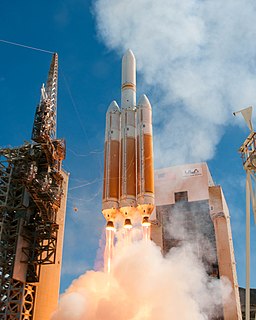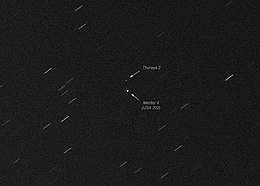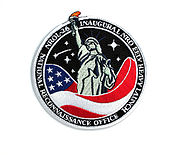
Cape Canaveral Space Force Station (CCSFS) is an installation of the United States Space Force's Space Launch Delta 45, located on Cape Canaveral in Brevard County, Florida.

Delta IV is a group of five expendable launch systems in the Delta rocket family introduced in the early 2000s. Originally designed by Boeing's Defense, Space and Security division for the Evolved Expendable Launch Vehicle (EELV) program, the Delta IV became a United Launch Alliance (ULA) product in 2006. The Delta IV is primarily a launch vehicle for United States Air Force (USAF) military payloads, but has also been used to launch a number of United States government non-military payloads and a single commercial satellite.

Atlas V is an expendable launch system and the fifth major version in the Atlas rocket family. It was originally designed by Lockheed Martin, now being operated by United Launch Alliance (ULA), a joint venture between Lockheed Martin and Boeing. Atlas V is also a major NASA launch vehicle.

United Launch Alliance (ULA) is an American spacecraft launch service provider that manufactures and operates a number of rocket vehicles that are capable of launching spacecraft into orbits around Earth and to other bodies in the Solar System. The company, which is a joint venture between Lockheed Martin Space and Boeing Defense, Space & Security, was formed in December 2006. Launch customers of the United States government include the Department of Defense (DoD), NASA, and other organizations.

Orion, also known as Mentor or Advanced Orion, is a class of United States spy satellites that collect signals intelligence (SIGINT) from space. Operated by the National Reconnaissance Office (NRO) and developed with input from the Central Intelligence Agency (CIA), eight have been launched from Cape Canaveral on Titan IV and Delta IV launch vehicles since 1995.

The Delta IV Heavy is an expendable heavy-lift launch vehicle, the largest type of the Delta IV family. It is the world's second highest-capacity launch vehicle in operation, behind SpaceX's Falcon Heavy, and closely followed by CNSA's Long March 5. It is manufactured by United Launch Alliance and was first launched in 2004.

Minotaur IV, also known as Peacekeeper SLV and OSP-2 PK is an active expendable launch system derived from the LGM-118 Peacekeeper ICBM. It is operated by Northrop Grumman Innovation Systems, and made its maiden flight on 22 April 2010, carrying the HTV-2a Hypersonic Test Vehicle. The first orbital launch occurred on 26 September 2010 with the SBSS satellite for the United States Air Force.
Integrated Overhead SIGINT Architecture, or IOSA, incorrectly reported to be codenamed Intruder, was a spy satellite system to be operated by the United States National Reconnaissance Office, which would have replaced the Mentor and Mercury systems. The satellites were reported to have been under development in 1995. The Intruder system was designed to combine the electronic signals intelligence (ELINT) and communications intelligence (COMINT) roles of signals Intelligence (SIGINT) spacecraft, which had previously been performed by different satellites, the Rhyolite and Vortex series respectively.
USA-223, known before launch as NRO Launch 32, is an American reconnaissance satellite which was launched in 2010. It is operated by the United States National Reconnaissance Office. It presently holds the record for being the largest spy satellite ever launched.

USA-225, also known as the Rapid Pathfinder Prototype (RPP) and NRO Launch 66 (NROL-66), is an American satellite which was launched in 2011. The satellite is being used to perform technology demonstration and development experiments, including advanced dosimeters to characterize the space environment from a 1,200 kilometer low Earth orbit. It is operated by the United States National Reconnaissance Office.

A heavy-lift launch vehicle, HLV or HLLV, is an orbital launch vehicle capable of lifting between 20,000 to 50,000 kg or between 20,000 to 100,000 kilograms into low Earth orbit (LEO). As of 2019, operational heavy-lift launch vehicles include the Ariane 5, the Long March 5, the Proton-M and the Delta IV Heavy. In addition, the Angara A5, the Falcon 9 Full Thrust, and the Falcon Heavy are designed to provide heavy-lift capabilities in at least some configurations but have not yet been proven to carry a 20-tonne payload into LEO. Several other heavy-lift rockets are in development. An HLV is between medium-lift launch vehicles and super heavy-lift launch vehicles.
USA-227, known before launch as NRO Launch 27 (NROL-27), is an American communications satellite which was launched in 2011. It is operated by the United States National Reconnaissance Office.
USA-184, also known as NRO Launch 22 or NROL-22, is an American signals intelligence satellite, operated by the National Reconnaissance Office. Launched in 2006, it has been identified as the first in a new series of satellites which are replacing the earlier Trumpet spacecraft.

USA-245 or NRO Launch 65 (NROL-65) is an American reconnaissance satellite which is operated by the National Reconnaissance Office. Launched in August 2013, it is the last KH-11 reconnaissance satellite, and the last spacecraft to be launched in the Keyhole program.
USA-198, known before launch as NRO Launch 24 (NROL-24), is an American communications satellite that was launched in 2007.











